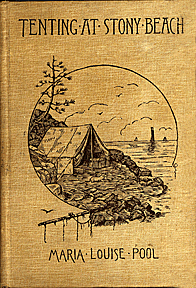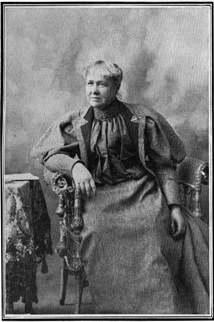Tenting at Stony Beach
By Maria Louis Pool
From The National Cyclopaedia:
Pool, Maria Louise, author, was
born at Rockland (then East Abington), Mass., Aug. 20, 1841, daughter
of Elias and Lydia (Lane) Pool. She received her education at the
public schools of her native place. She began to write early, and
before she was out of her teens became a contributor to the "Galaxy"
and other magazines. In 1870 she removed to Brooklyn, and after
fulfilling an engagement to write exclusively for a Philadelphia
paper, she began a connection with the "Evening Post" and the
"Tribune," of New York, which laid the foundation of her reputation.
in the latter paper her sketches, dated from Ransom, were very
favorably noticed for their almost photographic fidelity to New
England country life, and their qualities of humor and pathos. Among
her notable productions in book form are found: "A Vacation in a
Buggy" (New York, 1887); "Tenting at Stony Beach" (Boston, 1888);
"Dally" (1891); "Roweny in Boston"
(1892); "Mrs. Keats Bradford" (1892); "Katharine North" (1893);
"The Two Salomes" (1893); "Out of Step" (1894); "Against Human
Nature" (1895); "Mrs. Gerald" (1896); "In the First Person" (1898);
"Boss and Other Dogs" (1898); "A Golden Song" (1898), and "The Meloon
Farm" (1899). Miss Pool died in Rockland,
Mass., in 1898.
Note from the editor: Maria Louise Pool lived for 32 years
with her "literary companion," Caroline M. Branson, in Brooklyn, New
York, Wrentham, Mass., and for the last four years of her life in
Rockland, Mass. Their house stands on Liberty Street in Rockland,
near the corner of East Water Street. Maria Pool wrote openly about
her companionship with Caroline Branson, a relationship sometimes
described as a "Boston Marriage" in the late 19th century. The two
women are buried together in Mt. Pleasant Cemetary in Rockland, Mass.
Maria Pool lived a modest lifestyle typical of rural New England at
the time, and she was not an active participant in urban bohemian
artistic circles or an outspoken reformer. (Pool's contacts and
friendships with other women writers of the time has yet to be
explored.) Her writing represents a remarkably open depiction of a
homosexual couple in the late Victorian era, a record of a time in
which the lives of many commonplace homosexuals has been purged from
historical records. As Amand M. Hale writes in her biography,
the lives these women shared was too important to be written off as
simply friends or housemates, or left to be read between the lines.
Maria Pool mainly wrote genre stories about rural girls and women
(and their pet dogs). The stongest themes of love and companionship
between women can be found in "Tenting at Stony Beach," "Roweny
in Boston," and the companion novel "Mrs. Keats Bradford," "Sand
'n' Bushes" (set in Provincetown, Mass., in the 1890's), and "In a
Dike Shanty."
The editors of this World Wide Web edition of Maria
Louise Pool's work are interested in hearing from the readers.
Your response and comments will be useful in making future
decisions on expanding the selections offered.
This page is sponsored by J.R. Burrows &
Company, Historical-Design Merchants.
 J.R.
Burrows & Company
J.R.
Burrows & Company

